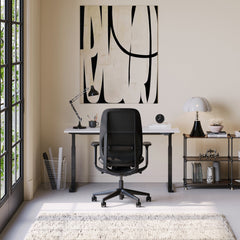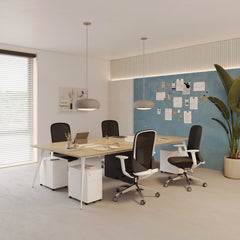Get 10% off your first order
Find the office furniture that’s designed to match your style, comfort, and needs perfectly. Subscribe
Beyond Desks and Chairs: How Cohesive Design Shapes Your Office Brand

Visit quiz page to see how we makes it easy to create an inspiring workplace


In the race for efficiency, businesses often focus on technology and training, overlooking the most fundamental tool for performance: the employee's physical comfort. The traditional office desk and chair, relics of a bygone era, are silently draining energy, focus, and productivity. When employees struggle with back pain, stiff necks, or eye strain, their attention shifts from the task at hand to their own discomfort.
Ergonomics is not a luxury; it is the strategic science of fitting the workplace to the worker. By investing in furniture designed to support the human body's natural movements and postures, companies do more than just prevent injury; they create an environment where sustained concentration and high-quality work are the default settings.
Wellness initiatives often stop at gym memberships or stress-reduction workshops. While valuable, true workplace wellness starts with the immediate physical environment. An ergonomic setup ensures that the body is supported in a neutral posture, minimizing muscle strain and maximizing blood flow to the brain. This proactive approach to health directly translates into fewer sick days, higher morale, and most importantly, higher-quality work. The furniture becomes a silent, always-on partner in health and performance.
The way an employee sits or stands directly affects their ability to focus. Slouching restricts lung capacity and strains the spine, leading to fatigue. When the body is correctly aligned, it operates efficiently, freeing up cognitive resources for complex tasks. Ergonomics ensures the body's natural alignment is maintained, regardless of the task duration.
Neutral posture means the joints are not bent awkwardly and the spine is aligned naturally. This is achieved when:
Feet are flat on the floor or a footrest.
Knees are at roughly a 90-degree angle.
Elbows are bent near a 90-degree angle, close to the body.
Wrists are straight, not bent up or down.
The top of the monitor is at or slightly below eye level.
By minimizing physical effort, the brain does not have to constantly send signals to adjust position or manage pain. This reduction in "body noise" allows for deeper, longer periods of concentration, directly boosting the complexity and accuracy of the work performed.
For a deeper understanding of how these interventions translate into tangible business benefits, including improvements in work quality and efficiency, a thorough review of published academic literature provides essential context, highlighting the proven correlation between a supportive workspace and employee output in the modern economy. You can find detailed findings and statistical analysis supporting these claims in established sources discussing ergonomic interventions and productivity.
The human body is designed to move. Static positions, even perfectly neutral ones, eventually lead to stiffness and reduced circulation. The modern ergonomic office must encourage and facilitate movement as a natural part of the workday. Movement is the antidote to the afternoon slump.
The health risks associated with prolonged sitting are widely known, including increased risk of chronic diseases. The workspace should actively mitigate these risks by providing options.
Circulation Boost: Alternating between sitting and standing dramatically improves blood flow. Better blood flow means more oxygen reaching the brain, leading to increased alertness and faster thinking.
Reduced Fatigue: Changing positions engages different muscle groups, preventing any single group from becoming overly stressed or tired.
For sustained energy and mental sharpness, the ability to change one's entire work position is vital. Providing workstations that promote this active work style is key. Equipping the office with premium standing desks allows employees to smoothly transition between sitting and standing throughout the day, ensuring the body remains active and the mind remains engaged.
Eye strain is a leading cause of workplace headaches and fatigue. In a computer-heavy environment, poor monitor placement forces the eyes and neck into unnatural positions, leading to discomfort that drastically reduces attention span. Ergonomic setups prioritize visual comfort.
The distance and angle of the screen are crucial for preventing strain.
Distance: The monitor should be approximately an arm's length away.
Height: The top of the screen should be at or slightly below eye level, which keeps the neck in a neutral, relaxed position.
Glare Control: Monitors should be positioned to avoid direct glare from windows or overhead lights. Anti-glare screens can also be beneficial.
When the eyes are comfortable, the brain processes information more efficiently, making long blocks of detailed work significantly easier and less taxing.
Ergonomic furniture is an investment in human capital that resonates far beyond physical comfort. It sends a powerful message to employees: We value your long-term health and well-being. This appreciation directly contributes to better mood and higher morale.
Providing adjustable, customizable workspaces gives employees a sense of control over their environment. This autonomy is psychologically empowering and leads to greater job satisfaction. Employees who can tailor their surroundings to their needs feel more respected and are, therefore, more motivated.
Decreased Stress: Reduced physical discomfort lowers overall stress levels.
Increased Loyalty: Employees are more loyal to a company that invests in their health.
Positive Perception: The physical environment itself becomes a positive anchor for the workday.

While general principles apply, true ergonomic performance requires personalization. Every individual has a unique body shape, size, and set of needs. A high-performing workspace must accommodate these variances, not force a one-size-fits-all solution.
The core workspace solution must offer extensive adjustability. For a high-performance setting, the quality of the primary work surface matters immensely. Professional quality desks should offer robust stability, generous surface area, and thoughtful cable management to eliminate visual and physical clutter. A desk that adapts to the user is essential for maximizing individualized comfort and output.
|
Feature |
Ergonomic Goal |
Performance Outcome |
|
Height Adjustment |
Accommodates varied torso lengths. |
Correct elbow angle for typing. |
|
Lumbar Support |
Matches natural spine curve. |
Prevents slouching and back pain. |
|
Adjustable Arms |
Keeps shoulders relaxed. |
Reduces neck and shoulder tension. |
Ergonomics is not just for individual workstations; it is equally vital in spaces designed for teamwork. Collaboration often requires people to quickly gather, share screens, and shift positions, which can quickly lead to awkward posture if the furniture is not designed for group dynamics.
Collaborative furniture must support simultaneous shared work and individual needs. Awkward seating or poor sight lines during a collaborative session are just as distracting as poor posture at an individual desk.
For efficient teamwork, integrated group setups are crucial. Utilizing a compact four-person workstation ensures that small teams have a dedicated hub that supports individual monitors and personal space while still encouraging easy conversation and screen sharing. These units are designed to maximize space while minimizing the physical friction of teamwork, allowing ideas to flow smoothly.
While traditionally focused on physical setup, true ergonomic design encompasses the entire sensory environment. Distractions that overwhelm the senses force the brain to work harder, accelerating mental fatigue.
Ergonomic design minimizes "sensory pollution" to allow the employee's attention to be directed only toward their task.
Acoustics: Use sound-dampening panels and floor coverings to absorb noise and create quieter working pockets.
Lighting: Control glare and provide customized task lighting so employees can avoid eye strain.
Visual Clutter: Ensure all furniture includes ample, integrated storage to keep surfaces clear of papers and cables.
The impact of ergonomics can be tracked in concrete business metrics. When physical discomfort is removed, the quality of focus improves, leading to a demonstrable reduction in errors and rework.
An employee distracted by a cramped neck or a numb leg is more likely to rush their work or miss crucial details. A comfortable employee can sustain concentration for longer periods, resulting in higher quality output.
☐ Reduced typing errors due to proper wrist and arm support.
☐ Fewer data entry mistakes due to better screen visibility.
☐ Lower instances of project rework due to sustained focus.
☐ More complex problem-solving achieved due to reduced mental fatigue.
The return on investment for ergonomic furniture is visible not only on the balance sheet but also in the quality of the final product or service delivered.
In competitive job markets, workplace quality is a key differentiator. Providing a genuinely ergonomic and health-conscious environment is a powerful recruiting and retention tool, particularly for skilled professionals.
Talented individuals seek out employers who prioritize their well-being. A high-quality ergonomic setup is seen as a sign of respect and investment, making the company more attractive to top candidates.
Reduced Turnover: Comfortable employees are happier employees, leading to less job hopping.
Fewer Absences: Lower rates of chronic pain problems mean fewer days lost to sick leave.
Institutional Knowledge: Retaining long-term employees protects the valuable institutional knowledge they hold.
Even in smaller, specialized markets, the commitment to employee comfort stands out. Finding high-quality, compact solutions, such as a Small Standing Desk Alabama, demonstrates that a company prioritizes customized health and efficiency, regardless of the office size or location.
The future of work is active, not passive. Ergonomic furniture serves as a constant, gentle reminder to move, stretch, and maintain good posture. It shifts the culture from one of passive sitting to one of active engagement with the workspace.
Physical health and mental acuity are intrinsically linked. An ergonomic environment supports this connection by:
Encouraging Micro-Breaks: Small, comfortable breaks to adjust a desk or change position act as mental resets.
Improving Respiration: Upright posture facilitates deeper breathing, increasing oxygen intake for the brain.
Boosting Energy: Reduced physical constraint means the body expends less energy fighting discomfort, leaving more available for cognitive tasks.
A comfortable body supports a sharp mind. Research confirms this connection; one study on ergonomic interventions in the workplace showed a significant positive correlation between proper equipment use and overall productivity.

The question is no longer if ergonomic furniture improves performance, but how much. By strategically integrating design that supports the human body, you eliminate the daily physical struggles that silently sabotage focus, energy, and quality of work.
Ergonomic design is a statement of value to your employees and a direct investment in your bottom line. It transforms the office from a static collection of furniture into a dynamic, health-conscious ecosystem. When employees are comfortable, they are free to perform at their peak. Choose to build a workplace that not only houses talent but actively empowers it.

Beyond Desks and Chairs: How Cohesive Design Shapes Your Office Brand

The Silent Energy Drain: Designing Tables and Chairs That Fight Work Fatigue

The Blueprint for Brilliance: Designing Workspaces For Team Focus
Get 10% off your first order
Find the office furniture that’s designed to match your style, comfort, and needs perfectly. Subscribe
Leave a comment